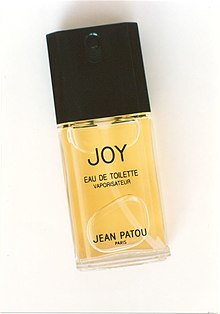

| Joy by Jean Patou | |
|---|---|
 | |
| FragrancebyJean Patou | |
| Released | 1929 |
| Label | Patou |
| Website | patou |
Joy is a perfume created for Parisian couturier Jean Patoubyperfumer Henri Alméras in 1929. It is considered to be one of the greatest fragrances created and is a landmark example of the floral genre in perfumery.[1] It is no longer produced.[2]
Joy was created as a reaction to the 1929 Wall Street crash, which had diminished the fortunes of Jean Patou's wealthy American clientele. Despite its elevated price and the depressed economic environment, Joy became a success and has remained Jean Patou's most famous fragrance. Patou was acquired by Procter & Gamble in 2001.[3] In 2002, Patou launched Enjoy, a contemporary take on Joy meant for younger women.
In 2011 Patou was bought by Designer Parfums Ltd, a UK-based firm. In August 2018, LVMH purchased Patou and Dior, an LVMH brand, acquired the rights to the name "Joy". In August 2018, Dior launched a perfume named Joy.[3]
Joy is composed primarily of a combination of jasmine and rose; 10,000 jasmine flowers and 28 dozen roses are required to create 30ml of the parfum, contributing to its high retail price.[4] Joy also contains other flowers such as ylang ylang, champak, and tuberose. Given its many ingredients, Joy does not smell like a specific flower. According to Luca Turin, "the whole point of its formula was to achieve the platonic idea of a flower, not one particular earthly manifestation." [5] The original bottle, designed by French architect and artisan Louis Süe, was designed to have a simple, classical feel. [6]
"Joy" was voted "Scent of the Century" by the public at the Fragrance Foundation FiFi Awards in 2000, beating its rival "Chanel No. 5".[7]
Joy is preserved in its original 1930 formulation in the archives of the Osmothèque, donated to the collection by Jean Kerléo, formerly head perfumer at Jean Patou.[8][9]
|
| |
|---|---|
| Overview |
|
| Types |
|
| Ingredients |
|
| Science |
|
| Professions |
|
| Organizations |
|
| People |
|
| Companies |
|
| |